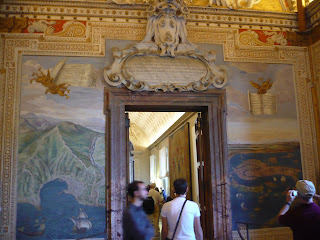The Vatican Museum was truly an inspiration.
We wandered through miles (literally) of rooms filled with amazing art, often the walls and ceiling were amazing art as well. The maps room was wonderful with huge wall maps of various places in Italy. There were rooms with frescoes painted by Raphael with a particularly interesting painting called “School of Athens” in which he honoured various figures of the day by painting them as the ancient great thinkers. Leonardo da Vinci is seen as Plato, for example. Apparently, Raphael included Michelangelo only as an afterthought. The great artists of the time competed for patron money and many didn’t get alo
The Sistine Chapel was indeed worth the entry fee. The frescoes are inspirational and the fact that Michelangelo painted this for four years while standing up made my neck hurt. I am surprised that Leonardo da Vinci didn’t get into the game and invent something to support the poor man’s neck wh
After the chapel, we headed over to Saint Peter’s Basilica. I have to say this was my favourite. I just loved the history attached to it. The basilica is huge. Did you know the shape of the Christian church is 
The whole area where Saint Peter’s square and basilica sit used to be a chariot race course (circus) during Roman times. During the half time break at the races, they would provide entertainment. Apparently, killing Christians was considered half time entertainment and Saint Peter was killed here. He was hung upside down on the

Bernini had a hand in most of the architecture and decoration inside the church, although the famous Pieta by Michelangelo also lives there. It is protected by bulletproof glass after some maniac with a hammer tried to add his mark to it. Bernini has a lot of amazing works throughout Rome and would have had more but the Pope who championed him died and the succeeding Pope didn’t like him. Same old story: it’s not what you know but who you know.
We saw two Bernini statues in the Gallery Borghese that were just amazing. The gallery isn’t part of the Vatican and you need a reservation to get in. It was well worth it. One  was “The Rape of Proserpine” and the other was “Apollo and Daphne”. I think those may be my favourite works of marble so far. The statue of Hades and Proserpine showed where Hades fingers were biting into Proserpine’s flesh as he held her. That and the tears on her face made the stone practically look alive. Painted, it must have been eerily real. In the statue of Apollo chasing Daphne, Bernini managed to freeze the movement of Apollo in such a way as to make it look real. His clothes are flying out behind him and his foot looks as though he is just pulling it in for another great stride. The leaves on the branches growing around Daphne also look delicate and alive. Rick said they actually make a ringing sound when hit by a hammer. I’d like to know who decided to hit the statue with a hammer.
was “The Rape of Proserpine” and the other was “Apollo and Daphne”. I think those may be my favourite works of marble so far. The statue of Hades and Proserpine showed where Hades fingers were biting into Proserpine’s flesh as he held her. That and the tears on her face made the stone practically look alive. Painted, it must have been eerily real. In the statue of Apollo chasing Daphne, Bernini managed to freeze the movement of Apollo in such a way as to make it look real. His clothes are flying out behind him and his foot looks as though he is just pulling it in for another great stride. The leaves on the branches growing around Daphne also look delicate and alive. Rick said they actually make a ringing sound when hit by a hammer. I’d like to know who decided to hit the statue with a hammer.
One other titillating tidbit about the gallery: the Cardinal who was responsible for gathering all the art there was a piece of work in his own right. He stole much of the art there through nefarious means. At least once, he had the owner of the art thrown in prison on a trumped up charge and then offered to let the owner out for a few of the owner’s precious art pieces. Another time the piece disappeared out of a home and reappeared some years later in his, acquired as a “donation” to the church. So you really couldn’t work up too much sympathy when you learned that Napoleon had “purchased” a lot of the collection under force. When Napoleon fell out of favour, the art couldn’t be returned because it had been paid for. It is at the Louvre now. I guess the prohibitive costs of the art prevented even the wealthy from buying it.
After our previous whining about the high costs and mediocre quality of museums in Rome, we realized we had saved the best for last. Skip the rest of the museums and blow your art budget at the Vatican and the Gallery Borghese.
Tuesday, May 17, 2011
The Holly Mother visits the Vatican
Subscribe to:
Post Comments (Atom)

1 comments:
Loved reading all of this. I guess I didn't think you were going to the Vatican...the pictures are Fantastic and to think that you all saw them! Double WOW...Love Mom
Post a Comment